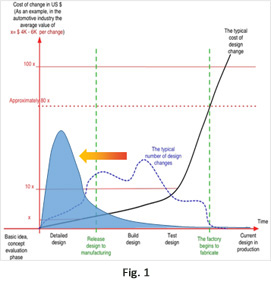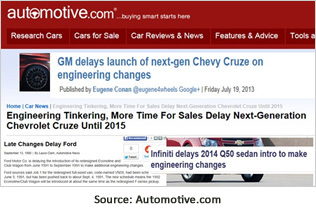Engineering Efficiency: How to Get More For Less!
With hundreds of new automotive models scheduled to launch over the next decade, automotive manufacturers, from OEMs to suppliers are striving to streamline design and engineering to speed up new launches and keep up with the growing demand. The 2013 IHS automotive Global Light Vehicle (LV) forecast anticipates total global LV sales will increase at a CAGR of 3.9%, reaching 106.7 million by 2020.
 What’s more, given the unprecedented launch activity surge in every industry, engineering resources are in high demand worldwide, significantly impacting R&D resource requirements in every industry. As a result, the ability to launch products quickly and cost effectively has never been more important but also never more challenging for R&D teams.
What’s more, given the unprecedented launch activity surge in every industry, engineering resources are in high demand worldwide, significantly impacting R&D resource requirements in every industry. As a result, the ability to launch products quickly and cost effectively has never been more important but also never more challenging for R&D teams.
Facing the lament of reducing product life cycles as well as resource shortage, R&D is left with one choice: To improve engineering efficiency. They are tasked to aggressively improve the efficiency, reduce the rework and minimize repetitive tasks – often consuming most of their time.
Rework is probably the biggest cause of waste in the engineering process.At least 30% of product development time and effort is spent on “rework” though Engineering Changes coming from various downstream stages of product development. The Engineering Changes originating in later stages of product lifecycle are very expensive leading to delayed product launch and cost over-runs.
 Figure 1 depicts a typical cost of design change curve for a new product design program. As you can see the cost of design changes increases exponentially as we go further in the product development lifecycle
Figure 1 depicts a typical cost of design change curve for a new product design program. As you can see the cost of design changes increases exponentially as we go further in the product development lifecycle
As per our estimates, average cost of engineering change in the automotive industry can be in the range of $4000-$6000, if detected at the early design stage. A change of this scope is easier to fix at this stage, as you can do a bit of redesign and remodeling and fix it. Furthermore, if you find an error during the testing stage, where most of the errors are detected, it takes almost $40k to $ 60k to fix. As a general thumb rule the cost of making design changes increases by a factor of ten at each step of the product development process.
 Finally, if the error gets past you into production or product has gone to market, then cost not only increases 100 times, but it can also have dire consequences in the form of costly product recalls , delays and loss of confidence amongst customers and shareholders, which is hard to quantify. Therefore, it is clear from Figure 1 that fixing errors is much more expensive and time-consuming the farther it is along it is in the product development life cycle. So the question becomes, what’s the best way to avoid changes occurring later in the product cycle?
Finally, if the error gets past you into production or product has gone to market, then cost not only increases 100 times, but it can also have dire consequences in the form of costly product recalls , delays and loss of confidence amongst customers and shareholders, which is hard to quantify. Therefore, it is clear from Figure 1 that fixing errors is much more expensive and time-consuming the farther it is along it is in the product development life cycle. So the question becomes, what’s the best way to avoid changes occurring later in the product cycle?
Build efficient design and engineering process to cut down iterations
Transformations in engineering process is instrumental in eliminating waste and reducing engineering changes. Decisions made in early design stage are responsible for most of the late-stage engineering changes. Though few changes are unavoidable and arise due to factors completely outside the control of the organization like change in regulations and customer needs. However, the remaining changes can be attributed under “preventable” category which can be addressed at the early stage of product development.
Shifting from a reactive to proactive approach where designer engineers can upfront verify the impact of design decisions and identify downstream issues as early as possible in the lifecycle process can significantly reduce engineering changes and maximize efficiency.
Our estimates show that by taking this approach, engineering productivity can be improved by 5%-15% and rework can be reduced by 6% -12% along with savings in overall cost and improved time to market.